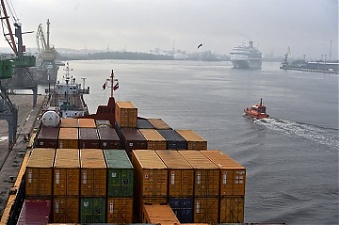Analytics, Cargo, Latvia, Port, Transport
International Internet Magazine. Baltic States news & analytics
Friday, 26.04.2024, 01:37
2019 at the Port of Riga
 Print version
Print version |
|---|
Furthermore, by implementing the concept of a smart port, projects related to advanced technology and e-commerce were launched. The port has also started significant upgrading works to reduce its environmental impact and improve the quality of life in local neighbourhoods.
Undeniably, opening the terminals in Krievu sala in 2019 was the most important event at the Freeport of Riga. It was the largest investment and infrastructure project ever implemented at the Port of Riga. It included construction of several berths and roads, a railway station, and an enormous wind barrier, as well as installation of the state-of-the-art handling technologies. At the beginning of this year, the first trains and ships arrived. The advanced technologies ensure more environmentally friendly and faster unloading of rail cars, as well as transportation of coal to vessels. The entire process is three times shorter. Moreover, the Krievu sala wind barrier that limits the spread of coal dust has also received the Annual Architecture Prize of Riga.
Port operators have also contributed to the development of port infrastructure and improvement of its general competitiveness. By completing a significant investment project at the beginning of this year, Rīgas Universālais Terminālis started receiving ships at its reconstructed birth, which was made longer and deeper by investing EUR 5 mln. During the opening of the birth, Jānis Kasalis, its Executive Director, said, “We understood that if we failed to invest in the development of our company, namely, a longer and deeper birth, the volume of cargo handled by us in the future would decrease and we would not be able to grow as we had planned to.”
At the beginning of summer, drainage of Kundziņsala residential area started. Due to rapid development of the port and construction of new infrastructure and terminals, the level of groundwater had increased in this part of Riga. The objective of the project was to prevent flooding of residential areas and reduce the consequences of industrial operations of the port, and to improve the quality of life of local residents.
A Chinese-Latvian e-commerce centre was also launched at the Port of Riga this year. During the opening ceremony, the first container with paints from Riga Paints and Dyes Factory was sent to China. This project has ambitious goals: to transform Riga into a significant e-commerce transit hub in the Baltic region.
In 2019, the port also focused on development of advanced technologies. In cooperation with LMT, test flights of 5G environmental monitoring drones were carried out at the Port of Riga. Thus, the port became one of the 5G pioneers.
Furthermore, in 2019 the structure of handled cargo changed considerably. Though the total turnover was smaller due to fewer coal and oil ships arriving at the port, record numbers were achieved in several cargo segments. The volume of timber and its products, in particular pellets and woods chips, rapidly increased. The volume of handled cereals also increased by 40%, and the volume of peat by 20%, which confirms that the volume of export cargo originating from Latvia is on the rise. Tallink, the operator of Riga-Stockholm ferry line, can also boast a record number of passengers carried.
- 28.01.2022 BONO aims at a billion!
- 25.01.2021 Как банкиры 90-х делили «золотую милю» в Юрмале
- 30.12.2020 Накануне 25-летия Балтийский курс/The Baltic Course уходит с рынка деловых СМИ
- 30.12.2020 On the verge of its 25th anniversary, The Baltic Course leaves business media market
- 30.12.2020 Business Education Plus предлагает анонсы бизнес-обучений в январе-феврале 2021 года
- 30.12.2020 Hotels showing strong interest in providing self-isolation service
- 29.12.2020 В Латвии вводят комендантский час, ЧС продлена до 7 февраля
- 29.12.2020 В Rietumu и в этот раз создали особые праздничные открытки и календари 2021
- 29.12.2020 Latvia to impose curfew, state of emergency to be extended until February 7
- 29.12.2020 18-19 января Наталия Сафонова проводит семинар "Управленческий учет во власти собственника"








 «The Baltic Course» Is Sold and Stays in Business!
«The Baltic Course» Is Sold and Stays in Business!

